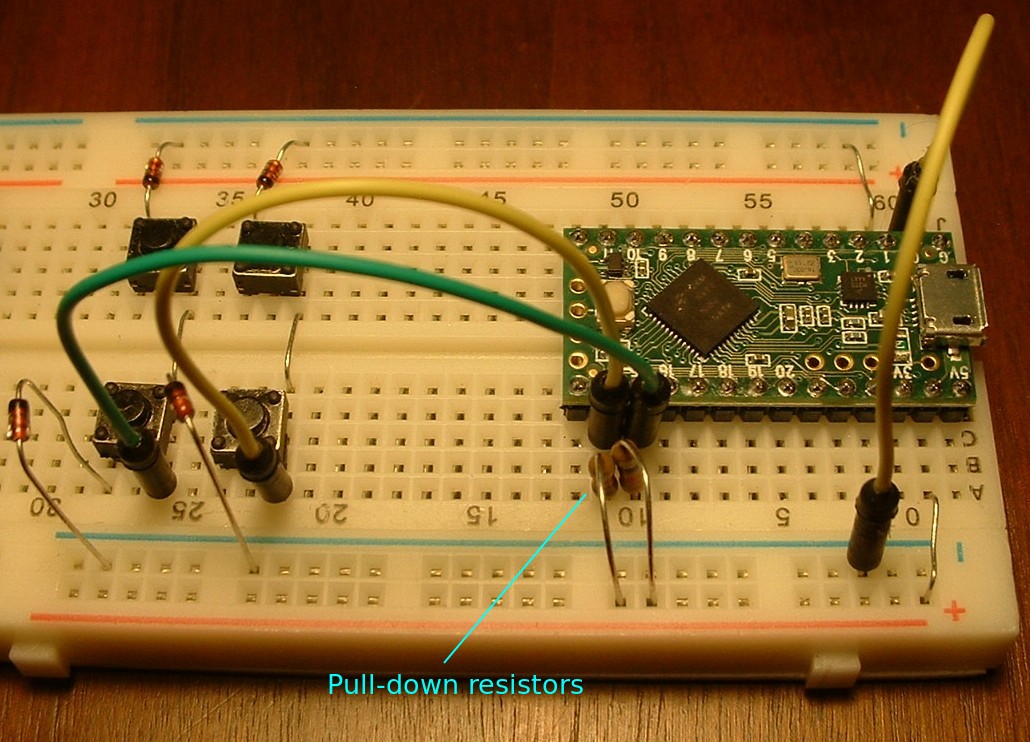tutorial_6_active_high.md 4.6KB
Tutorial 6 - Active high
This tutorial pulls together several concepts needed to understand active state in the context of a keyboard. Skip to the end of this tutorial if you just want to copy an active-high keyboard.
Pull-up resistors
There are many sources that explain “pull-up resistors”, so I won’t repeat it here. Here is a good tutorial on Pull-up Resistors.
Active low
All the keyboards up to this point in the tutorial series have used active low with internal pull-up resistors.
“Active low” means that if a switch is pressed (active state), the read pin is low. When the switch is released (inactive state), the pull-up resistor pulls the read pin high.
The following table traces the strobe current from left to right (0 is ground, 1 is power).
If the switch is closed, the strobe current passes through the switch and pulls the read pin low.
If the switch is open, the pull-up resistor pulls the read pin high.
| Strobe pin on | Diode orientation | Switch position | Pull resistor | Read pin state |
|---|---|---|---|---|
| 0 | cathode -:<- anode | close | 1 pull-up | 0 active low |
| 0 | cathode -:<- anode | open | 1 pull-up | 1 inactive high |
Arduino boards have internal pull-up resistors, which saves on parts and labor compared to manually adding external pull resistors.
To make a keyboard active low:
- Orient diodes with cathode (banded end) towards the write pins (row)
- Define strobe on and strobe off in the sketch like this:
const bool Scanner_uC::STROBE_ON = LOW; const bool Scanner_uC::STROBE_OFF = HIGH;
Active high
“Active high” means that if a switch is pressed (active), the read pin is high. When the switch is released (inactive), the pull-down resistor pulls the read pin low.
The following table traces the strobe current from left to right (0 is ground, 1 is power).
If the switch is closed, the strobe current passes through the switch and pulls the read pin high.
If the switch is open, the pull-down resistor pulls the read pin low.
| Strobe pin on | Diode orientation | Switch position | Pull resistor | Read pin state |
|---|---|---|---|---|
| 1 | anode ->:- cathode | close | 0 pull-down | 1 active high |
| 1 | anode ->:- cathode | open | 0 pull-down | 0 inactive low |
Arduino boards do not have internal pull-down resistors.
If you want to use active low, you will have to add external pull-down resistors to the read pins.
To make a keyboard active high:
- Add an external 10k pull-down resistor to each read pin
- Orient diodes with cathode (banded end) towards the read pins
- Define strobe on and off in the sketch like this:
const bool Scanner_uC::STROBE_ON = HIGH; const bool Scanner_uC::STROBE_OFF = LOW;
Making a breadboard keyboard active-high
This tutorial converts the basic breadboard keyboard from tutorial 1 to active high. By comparing the above tables, one can see what changes need to be made:
- add external pull-down resistors to the read pins
- flip the diodes so that the cathode (banded end) are towards the read pins
- swap the STROBE_ON and STROBE_OFF values
The red bus is grounded. The pull-down resistors plug into the red bus and column read pins.
The keybrd_6_active_highsketch.ino is the tutorial 1 sketch with STROBE_ON and STROBE_OFF values swapped.

keybrd tutorial by Wolfram Volpi is licensed under a Creative Commons Attribution 4.0 International License.
Permissions beyond the scope of this license may be available at https://github.com/wolfv6/keybrd/issues/new.

